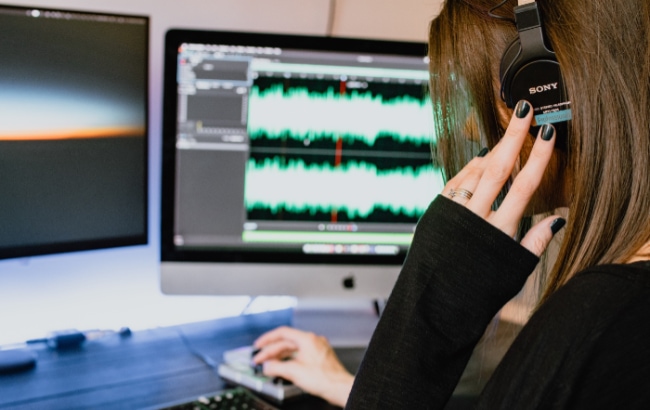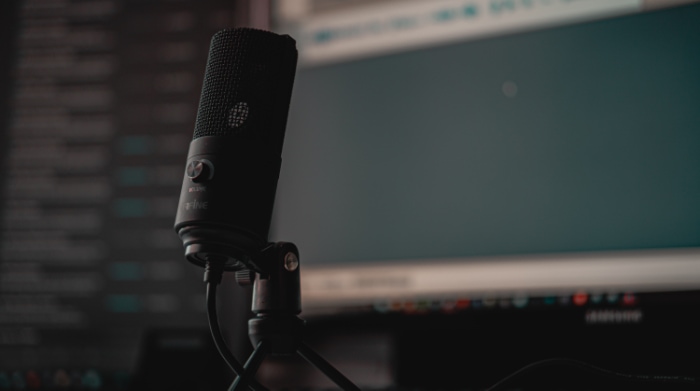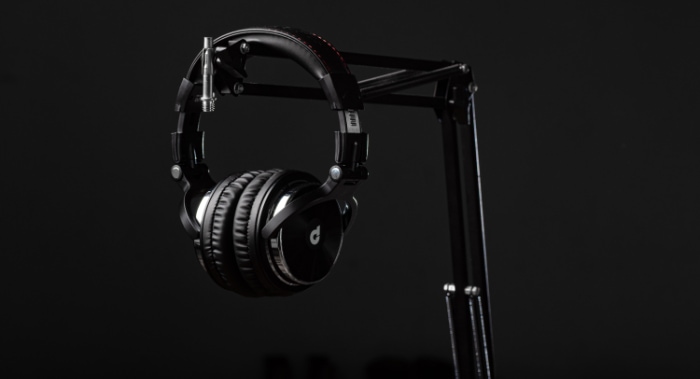What Is Sampling Rate, Sample Depths, and Bit Rates?
Whether you’re working in video, audio, or gaming, getting the most out of your production requires a solid understanding of sampling theory and audio fundamentals – including concepts like frequency response, sample rates, sample depths, and bit rates.
But what do these terms mean? When should they be considered? And how do they relate to one another? Understanding sampling rates, sample depths, and bit rates are critical to ensuring that content plays back properly across a wide range of devices – from mobile phones to A/V receivers.
Let’s take a look at each concept individually so you can make sure your projects sound as good as possible!
What Is Sampling Rate?
Let’s begin with a bit of background. It’s important to understand that digital audio – that is, audio recorded in digital form – is fundamentally different from audio recorded with analog devices.
This is because audio recorded with an analog device, whether a microphone or a turntable, is stored as a continuous measurement of pressure or current, with individual measurements being taken at a specific rate. As you may or may not know, this rate is referred to as the sampling rate, and it’s typically expressed in Hertz (Hz).
So, how do we know how many measurements will be taken at a given sample rate?
Well, it depends on the device that’s being used to capture the audio. For example, if you were capturing sound with a microphone that was capable of recording at 48 kHz, you would receive 48,000 discrete measurements of pressure every second.
Conversely, if you were using a turntable capable of recording at 33 RPM, you would receive 33 discrete measurements every second.
To get a concrete example, let’s look at a popular digital audio storage format (CD) and one of its “ancestors” (vinyl) and quickly compare the different sampling rates.
A Compact Disc with a sampling rate of 44.1 kHz (or 44,100 Hz) will capture 44,100 measurements of pressure for every second.
Assuming that a particular disc has a recording duration of 60 minutes, this would mean that a total of 2,304,000 measurements would be captured.
On the other hand, a vinyl record with a sampling rate of 33.35 kHz (33,350 Hz) would capture 33,350 measurements for every second. Assuming that the recording duration is the same (60 minutes), this would mean that a total of 484,500 measurements are captured.
Now with the basic theory behind us, let’s look at some of the important considerations.
The most common sampling rates that audio professionals use are 44.1 kHz (44100 Hz), 48 kHz (48000 Hz), and 96 kHz (96000 Hz). The reason for this is two-fold.
First, since 44.1 kHz is the sampling rate of a Compact Disc, virtually all software and hardware are capable of recording and playing back audio at this sampling rate.
Second, most professional audio software and hardware is capable of recording audio at 48 kHz, thus providing a “half-step” up from 44.1 kHz. Since the 48 kHz sampling rate is the sampling rate of a Compact Disc and is commonly used in the field, it’s easy to see that the 48 kHz sampling rate is a popular choice for recording audio as well.
Lastly, the 96 kHz sampling rate is widely accepted as a choice for mastering audio.
What Is Sample Depth?
Now with the sampling rate out of the way, we can get into the next most significant consideration – sample depths. Sample depth, which is measured in bits per sample, is the amount of data that is captured and/or manipulated in audio, typically measured in bits.
The greater the sample depth, the more information is captured and/or manipulated, and the more detail we can expect to hear.
For example, if we were capturing a recording of a solo instrument, we probably would want to use a sample depth of at least 24 bits since this amount of depth would capture the most detail.
On the other hand, if we were capturing a recording of a full orchestra, we probably would not want to use a sample depth of at least 24 bits. This is because this amount of depth would so tremendously over-sample the audio that it would result in a loss of quality.
Sample precision is the number of bits that the audio is encoded or decoded into or from, typically measured in bits. As we should know by now, the higher the sample depth, the greater the sample precision. However, there is a trade-off that we need to make.
As you may already know, the larger the sample depth, the more information is captured and/or manipulated. This can result in a loss in performance, especially when we’re dealing with high sample rates.
This is because the number of calculations that are performed per second will increase as the sample rate increases, and the more calculations we have to make, the more performance we need out of our computer.
This can be overcome, however, if the audio is processed through a series of algorithms (such as a decimation filter) that are designed to reduce the processing requirements at high sample rates.
But in order to do this, we need to have access to the highest sample depths and precision possible.
The sample size is the amount of data that we capture or manipulate, typically measured in bits. To get a concrete example, let’s examine a Swiss Army knife of a digital audio format – the DSD format. DSD (Direct Stream Digital) is a format that has both a sample rate and a sample depth of a single bit.
What this means is that the only data that is captured or manipulated is the amplitude of a single bit. And since the amplitude of a single bit is either high (1) or low (0), this means that there is a total of two possible states of the audio. In other words, there is no middle ground in the audio – it’s either “on” or “off.”
This is important because it means that DSD is essentially a “deterministic” format. If something happens, it always happens. As a result, it doesn’t have the issues that plague “probabilistic” formats, such as signal-to-noise ratio and distortion.
As DSD is essentially a “deterministic” format, it’s best that we use it for recording and playback at low sample rates (32 kHz and above) and processing at higher rates.
What Is Bit Rate?
Bit rate is that one key that unlocks the digital audio door. It’s the one piece of the digital audio puzzle that is responsible for determining whether or not your audio will sound as good as possible.
This is because the bit rate determines how much information is stored per second. The higher the bit rate, the more information is stored per second. This can be expressed by calculating how many kilobits are recorded per second. For example, a bit rate of 256 kbps (kilobits per second) means that 256,000 bits are stored every second.
As most of you know, the bit rate is usually dictated by the sampling rate and the number of channels that comprise the audio. The higher the bit rate, the more information that is stored per second, which essentially means that the higher the bit rate, the better the audio quality. And this is where it gets really confusing.
The bit rate is determined by the sampling rate and the number of channels that comprise the audio. So, for example, if a song is recorded in stereo, the bit rate is usually 128 kbps (kilobits per second), which means that 128,000 bits are stored every second.
This is commonly referred to as the ‘bit rate.’ If a song is recorded in mono, it would have a ‘bit rate’ of 64 kbps (kilobits per second). So, the higher the bit rate, the better the audio quality.
Apart from the sampling rate and the number of channels, the other thing that determines the audio quality is the compression method that is used to compress the audio file. The compression method does not affect the bit rate in any way.
When the audio file is compressed (usually with a lossy compression technique), it affects the audio quality by degrading the audio (a.k.a. reducing the audio quality). Formats like ACC or MP3 use lossy compression, while formats like FLAC or ALAC use lossless compression.
So now that we have established what the bit rate and the compression method are and how they affect the audio quality, you should now have a decent understanding of the bit rate needed to produce a certain audio quality.
As a rule of thumb, the higher the bit rate, the better the audio quality.
Conclusion
Hopefully, this article has given you some perspective on how sampling rates, sample depths, and bit rates work together to let you produce the best audio content possible.
If you are looking for the best possible audio quality for a project, we recommend that you capture the audio at 24-bit, 192 kHz in an uncompressed format (such as WAV or AIFF).





